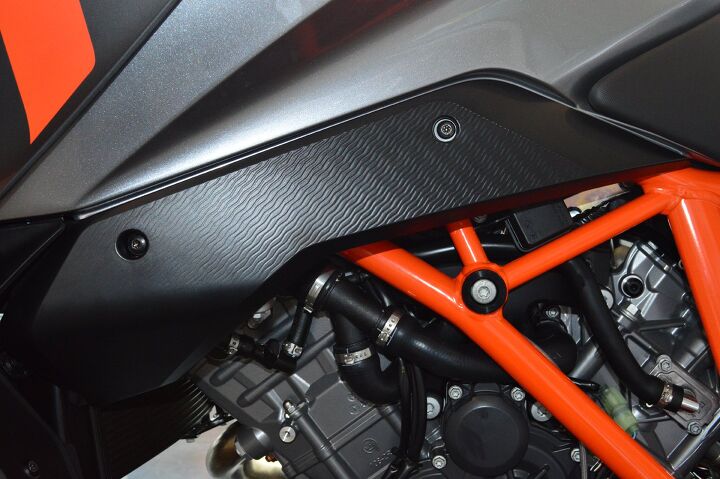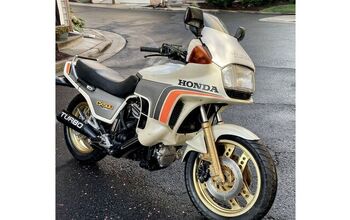Top 10 Cool Facts About The KTM 1290 Super Duke GT

Every chance we get, we profess our love for KTM’s 1290 Super Duke R, MO’s 2014 Motorcycle of the Year. Aggressive styling matched with a monstrous engine, sophisticated electronics, sportbike-like handling, and reasonable comfort all combined to win our hearts that year. For 2016, KTM is adding to its impressive lineup with the SDR’s cousin, the 1290 Super Duke GT. Aimed for those wanting a Super Duke R but with all-day comfort and some storage space in the form of saddlebags, the SD-GT inspires big hopes in us. In fact, E-i-C Kevin Duke will be putting it through its paces at the bike’s launch in Spain during the beginning of March.
In advance of Kevin providing riding impressions of the bike in his First Ride Review, I’ve compiled 10 fun facts about the Super Duke GT I learned during a recent visit to KTM headquarters in Mattighofen, Austria.
10. No Focus Groups
Lead designer for all KTM motorcycles, Craig Dent, pictured here, considers the Super Duke R and Super Duke GT as his pet projects. The restrictions and regulations placed on road-going motorcycles are challenges not encountered when designing KTM’s dirtbikes. When it came time to put pen to paper and sketch up his vision for the SDR and SD-GT, the London native now living in Austria says quite candidly, “We didn’t consult with focus groups.” Instead, direction for the two models came from a gut feeling centered on aggressiveness and lightness. The latter has less to do with physical weight (though that’s important, too), and more to do with appearing visually uncluttered.
9. Inspired by Rucksacks
While designing the Super Duke GT, Dent says he and his team forced themselves to seek inspiration from any aspect of life outside of motorcycles, no matter how foreign it might have seemed. Comfort and complacency are the enemy, says Dent, when it comes to product design – especially as it relates to KTM’s core value of “Ready to Race.” So, what’s an example of this outside-the-box thinking? The texture of this panel, for instance, was inspired by the shoulder strap of a rucksack.
8. Form and Function, Together
In staying with Dent’s theme of aggressiveness and lightness, those two guidelines often mean neither form nor function gets the upper hand. Instead, the two are one in the same. Dent uses the front fairing stay for the Super Duke GT as an example. He’s seen other motorcycles use a metal frame structure to support the front fairing and gauges, which would then be hidden or covered by the rest of the motorcycle’s bodywork. Not so with the Super Duke GT. From the onset, the fairing stay was designed to be sturdy enough to support the headlight, gauges, windscreen, etc., while also being able to withstand side wind gusts. That said, its physical shape wasn’t sacrificed to meet these goals, its angularity blending with the rest of the design.
7. More Than Just a Subframe
We all know any touring bike even remotely based on a standard model will likely have to have its subframe beefed up in order to support the added weight of a passenger and luggage. The Super Duke GT is no different. However, an advantage Dent and his team at Kiska have is access to KTM engineers within the building. Consequently, Dent and his team are able to produce rapid prototypes all in-house, speeding up the trial-and-error process in the event a prototype needs adjusting once placed on the full-size clay model. For instance, only three iterations of subframe were required for the Super Duke GT before it was finalized for production.
6. Five-Axis IMU
Inertial Measurement Units are all the rage these days in motorcycle safety, and the Super Duke GT will come equipped with a Bosch five-axis unit seen on a couple other KTM models, as well as those seen on other makes. What you may not have realized is the physical size of the IMU. I personally take for granted the physical size of motorcycle components like an IMU, so it’s remarkable that this potentially life-saving device is about one-third the physical size as my Samsung Galaxy S5 smartphone.
5. Semi-Active Suspension
Like IMUs, semi-active suspension isn’t a new technology either, not even for KTM as it was used on the 1290 Super Adventure, but now it’s a technology that will see its way onto the Super Duke GT. KTM’s sister company, WP Suspension has been working on its semi-active suspension technology since 2007, having introduced its third generation units in 2010. Interestingly, WP only started on-road testing of its semi-active suspension tech in September of 2011, taking more than three years before deeming it ready for production on the Super Adventure.
4. Rapid Prototyping
According to Dent, he and his fellow Kiska designers, once given a design brief, start their CAD drawings with something resembling the shape of a ball. By adding points at certain spots, then manipulating those points, they can come up with something that looks roughly like a motorcycle within an hour. Within a week a full-size clay model like this one of the Super Duke GT is possible. That blue box seen behind the white wall to the right of the frame is a milling machine, used to make rapid prototypes of various items from the subframes discussed earlier, to body panels and fuel tanks.
3. Wires For Days
Sometimes it’s difficult to quantify the amount of technology we enjoy on today’s motorcycles. This should put that into perspective. Here is Martin Forster, Head of Components Development at KTM. In his left hand he’s holding the wire harness for a 1999 KTM Duke with the LC4 engine. Meanwhile, in his right hand is the wire harness for a 1290 Super Adventure and its LC8 engine which is shared with the Super Duke GT. With numerous sensors, systems, and subsystems talking to each other all trying to either keep the motorcycle operating or the rider from crashing, it’s remarkable to think this amount of wires and cables are stuffed throughout the motorcycle.
2. Suck, Squish, Bang, Blow
Here’s one of KTM’s engine dyno operators putting an LC8 engine through its paces. The dynos usually aren’t seeking outright power, instead the technicians are testing for anything ranging from unexpected noises or vibrations to engine durability. Up to six different fuel types can be tested, giving a sampling for fuels used throughout the world and how best to map for them. These engine dynos are also used to achieve optimum fuel mapping when a customer purchases an aftermarket exhaust from one of KTM’s accessory partners: Akrapovic and FMF.
1. It’s Put on the Rotisserie
During a KTM model’s fatigue testing, technicians like Benjamin Riemer place the motorcycle on this jig. Capable of six height positions, Riemer can measure loads at each end, the center of gravity, and even its inertia. That apparatus the Super Duke GT is placed in can swing like a grandfather clock while sensors measure any number of items. Elsewhere in this room (to the left of frame), different components like wheels and suspension pieces are put through rigorous torture tests to test strength and durability.

Troy's been riding motorcycles and writing about them since 2006, getting his start at Rider Magazine. From there, he moved to Sport Rider Magazine before finally landing at Motorcycle.com in 2011. A lifelong gearhead who didn't fully immerse himself in motorcycles until his teenage years, Troy's interests have always been in technology, performance, and going fast. Naturally, racing was the perfect avenue to combine all three. Troy has been racing nearly as long as he's been riding and has competed at the AMA national level. He's also won multiple club races throughout the country, culminating in a Utah Sport Bike Association championship in 2011. He has been invited as a guest instructor for the Yamaha Champions Riding School, and when he's not out riding, he's either wrenching on bikes or watching MotoGP.
More by Troy Siahaan






































Comments
Join the conversation
If we use the number 1 to represent the volume of an FJRs side cases, what number represents the SDGT side cases?
Ad talk aside, I'm sure the SDR1290 wiring loom was not designed - it just came... Ok, all manufacturers do that garage (or is it backyard?) work. Anyway, would like to have a decent one, one day. And, they have some very nice quality level parts there (like valves from Del West might be expensive but top class).
And what about the airbox? Will the person who designed that, come forward? I would like to give him a tube of RTV as a present so he too can have an airtight one...
And the airducts! They are to me an example of not a thorough design but a surface-oriented attitude.